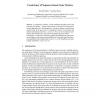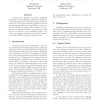RECOMB
2010
Springer
14 years 11 months ago
2010
Springer
151
click to vote
RECOMB
2010
Springer
14 years 11 months ago
2010
Springer
In comparative genomics, various combinatorial models can be used to specify gene clusters — groups of genes that are co-located in a set of genomes. Several approaches have been...
114
Voted
RECOMB
2010
Springer
14 years 11 months ago
2010
Springer
Motivated by the trend of genome sequencing without completing the sequence of the whole genomes, Mu˜noz et al. recently studied the problem of filling an incomplete multichromos...
106
Voted
RECOMB
2010
Springer
14 years 11 months ago
2010
Springer
We consider the following problem: given a forest of gene family trees on a set of genomes, find a first speciation which splits these genomes into two subsets and minimizes the ...
147
click to vote
RECOMB
2010
Springer
14 years 11 months ago
2010
Springer
Abstract. We describe a probabilistic model, implemented as a dynamic Bayesian network, that can be used to predict nucleosome positioning along a chromosome based on one or more g...
RECOMB
2010
Springer
14 years 11 months ago
2010
Springer
128
click to vote
RECOMB
2010
Springer
14 years 11 months ago
2010
Springer
We study two problems in the double cut and join (DCJ) model: sorting – transforming one multilinear genome into another and halving – transforming a duplicated genome into a p...
125
click to vote
RECOMB
2010
Springer
14 years 11 months ago
2010
Springer
Abstract. In a horizontal gene transfer (HGT) event a gene is transferred between two species that do not share an ancestor-descendant relationship. Typically, no more than a few g...
116
Voted
BICOB
2010
Springer
14 years 11 months ago
2010
Springer
A decision tree induction method for multilabel classification tasks (IS-MLT) is presented which uses an iterative approach for determining the best split at each node. The propo...
119
Voted
BMCBI
2004
15 years 15 days ago
2004
Background: Hidden Markov Models (HMMs) have proven very useful in computational biology for such applications as sequence pattern matching, gene-finding, and structure prediction...


